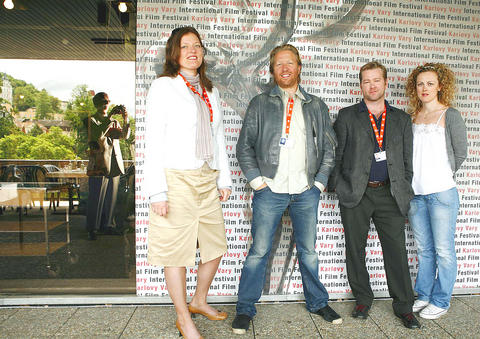With his coal-black comedy The Art of Negative Thinking, Norwegian director Bard Breien gleefully eviscerates the phony-baloney, "feel good" psychoanalytic babble that is so often hurled thoughtlessly at the severely disabled. Breien's main character, National Health Psychologist Tori (Kjersti Holmen), embodies this approach. All optimistic saccharine on the surface, but a steamroller underneath, she refuses to tolerate any pessimism, cynicism, depression or anxiety from her patients. The latter include: gorgeous Marta, a mountain climber almost completely paralyzed from a fall; her troubled paramour Gard (Henrik Mestad), grappling with guilt thanks to his direct responsibility for the accident; Lillemor (Kari Simonsen), a shrill and obnoxious, sexagenarian divorcee saddled with a neck brace and constantly tossed the "shit bag" in therapy - a tea cozy used as a means of disposal for her complaints; and Asbjorn (Per Schaaning), a stroke victim. All of these patients can deal with Tori's positivism - more or less. But not so with Geirr (Fridtjov Saheim), a paraplegic from an accident who spends his days drowning himself in booze, chain-smoking cigarettes, and listening to depressing Johnny Cash ballads. When Geirr's wife learns of Tori's methods and decides to bring the good doctor to the house to help rehabilitate her husband, it sets the stage for a battle of positive versus negative thinking, that threatens to explode into full-scale cataclysm.

PHOTO: EPA

Wooden houses wedged between concrete, crumbling brick facades with roofs gaping to the sky, and tiled art deco buildings down narrow alleyways: Taichung Central District’s (中區) aging architecture reveals both the allure and reality of the old downtown. From Indigenous settlement to capital under Qing Dynasty rule through to Japanese colonization, Taichung’s Central District holds a long and layered history. The bygone beauty of its streets once earned it the nickname “Little Kyoto.” Since the late eighties, however, the shifting of economic and government centers westward signaled a gradual decline in the area’s evolving fortunes. With the regeneration of the once

Even by the standards of Ukraine’s International Legion, which comprises volunteers from over 55 countries, Han has an unusual backstory. Born in Taichung, he grew up in Costa Rica — then one of Taiwan’s diplomatic allies — where a relative worked for the embassy. After attending an American international high school in San Jose, Costa Rica’s capital, Han — who prefers to use only his given name for OPSEC (operations security) reasons — moved to the US in his teens. He attended Penn State University before returning to Taiwan to work in the semiconductor industry in Kaohsiung, where he

In February of this year the Taipei Times reported on the visit of Lienchiang County Commissioner Wang Chung-ming (王忠銘) of the Chinese Nationalist Party (KMT) and a delegation to a lantern festival in Fuzhou’s Mawei District in Fujian Province. “Today, Mawei and Matsu jointly marked the lantern festival,” Wang was quoted as saying, adding that both sides “being of one people,” is a cause for joy. Wang was passing around a common claim of officials of the People’s Republic of China (PRC) and the PRC’s allies and supporters in Taiwan — KMT and the Taiwan People’s Party — and elsewhere: Taiwan and

Perched on Thailand’s border with Myanmar, Arunothai is a dusty crossroads town, a nowheresville that could be the setting of some Southeast Asian spaghetti Western. Its main street is the final, dead-end section of the two-lane highway from Chiang Mai, Thailand’s second largest city 120kms south, and the heart of the kingdom’s mountainous north. At the town boundary, a Chinese-style arch capped with dragons also bears Thai script declaring fealty to Bangkok’s royal family: “Long live the King!” Further on, Chinese lanterns line the main street, and on the hillsides, courtyard homes sit among warrens of narrow, winding alleyways and